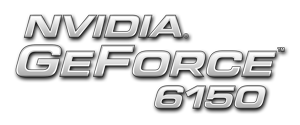GeForce 6100 and 6150 IGPs

GeForce 6100 and GeForce 6150 are available for pairing with 410 and 430 MCPs to create integrated graphics solutions. Again, the main differences are served best in table format. Codenamed C51, there's a fair difference between the two versions of that GPU.
| Feature | GeForce 6100 | GeForce 6150 |
| HD Video | No | Yes |
| TV Encoder | No | Yes |
| Can act as a 2nd head | No | Yes |
The 6100 therefore sits as the very low cost version of the two, not fast enough or feature rich enough to warrant using outside of anything but very cheap systems. 6150 is much more interesting, offering support for HD Video (although only H.262-class at good speed right now), a TV encoder (for output to TV) and support for running itself as another display output on your PC system in conjunction with a discrete graphics card.
6150 is a PureVideo-supporting graphics chip from NVIDIA, so it gets driver support for HD video (although NVIDIA were only able to demonstrate it decoding H.262/MPEG-2/DVD-class video during the launch presentation, support for H.264-class decode acceleration seemingly coming later).
Both versions have two fragment units, one vertex unit and two pixel output engines. Clocks are 475Mhz for the 6150 and 425MHz for 6100. Both parts support Shader Model 3.0, bringing that to integrated graphics for the very first time in a DX9-class part.
The TV encoder on the 6150 supports component, S-Video and compostive out, as well as a TMDS for DVI support. DVI on the mainboard backplane will be cool to see. Both chips are also able to be passively cooled, bringing us on nicely to the announcement that these two parts and NVIDIA's first graphics products created on a 90nm process. Manufactured by TSMC, the 90nm process allows NVIDIA to back the transistors needed for the 6100 and 6150 into a chip package small enough and frugal enough to sit on the mainboard and be passively cooled even at top clocks.
NVIDIA are open about the fact the spec of both 6100 and 6150 aren't up to HD gaming, and Tarinder will be comparing the 6150 variant to various low-end discrete boards to see where performance sits.
Finally and quite obviously, the GPUs use NVIDIA TurboCache technology to dynamically use system memory as local GPU memory for framebuffer space and 3D processing.









